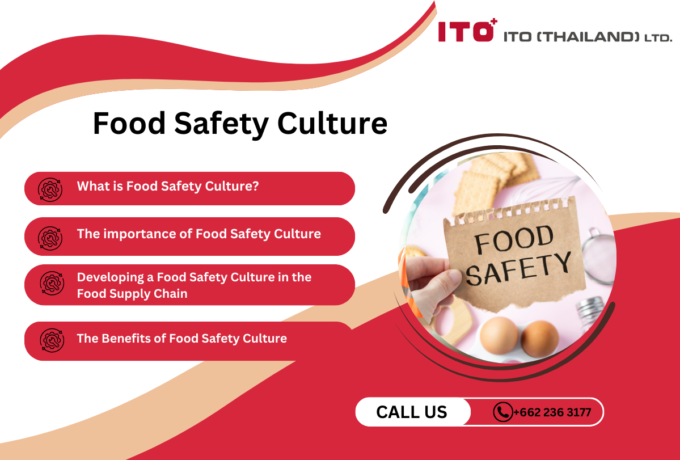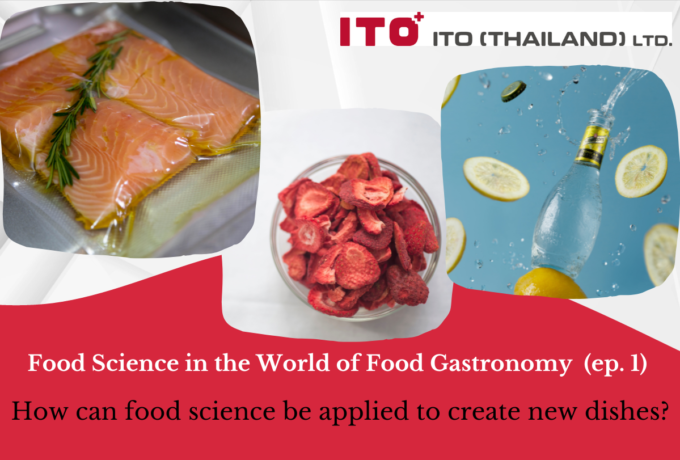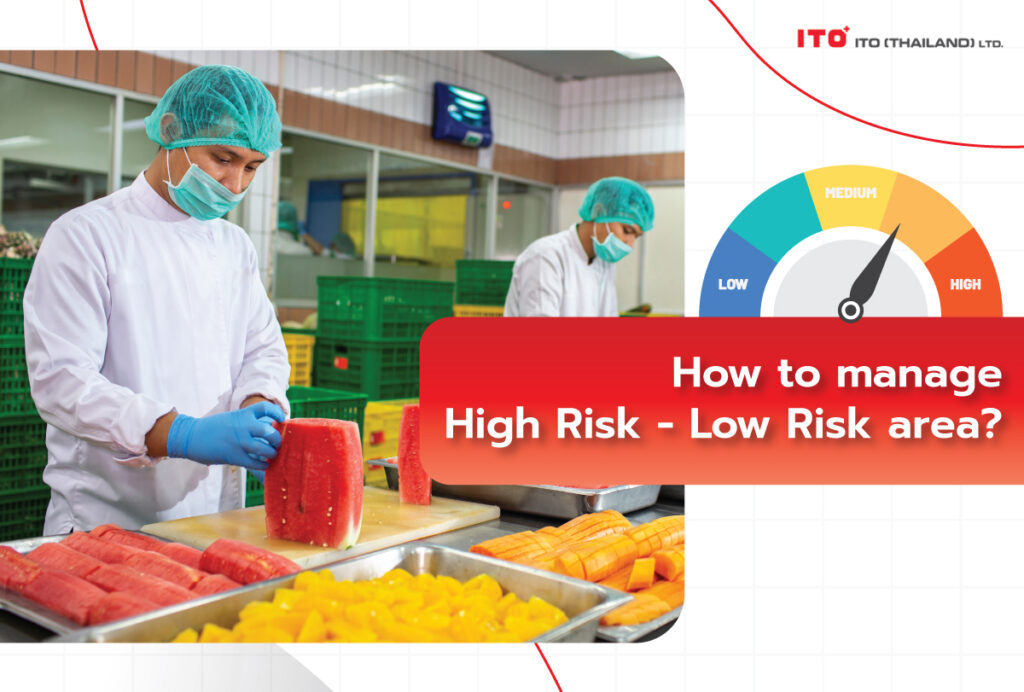ITO Thailand Hygiene Blog
Area Risk Assessment
Open Area For Production means the area where the food, whether in the form of raw materials, in the process of processing or in the form of a product, is not protected from the environment (this includes products with natural shells such as eggs and nuts [2]), allowing various contaminants such as dirt, allergens, microorganisms and so on to enter the food from the environment (for example, microbial contamination, which is both a risk factor for foodborne illnesses from pathogens and can deteriorate the product before the expiration date. The level of risk to be assessed means the risk of contamination with pathogenic microorganisms and deterioration of food including the possibility of growth and survival of contaminated microorganisms). The area can be divided according to the level of risk as follows:
High-risk area
High-risk area is a designated area for refrigerated and frozen products because the products that are stored at low temperature are often environmentally sensitive products, for example, easily deteriorating under unsuitable temperatures or in a condition where microorganisms can grow well (has proper level of pH, moisture, nutrients, and so on), so the growth of microorganisms must be inhibited by storing at low temperatures. Therefore, this group of food has a high risk of developing cases of food insecurity. The BRC standard therefore stipulates that in the case of food production areas in this group are open to the environment (not in a pipe, enclosed vessel, or closed system) and have already been given the criteria (final product must be stored in refrigerated or frozen conditions, ingredients must undergo a minimum heat of 70 °C for 2 minutes (or equivalent) prior to entering this area, product is at risk of pathogenic growth during storage or use, and products in the ready-to-eat or ready-to-heat group that will not undergo the process of re-cooking), production area is considered high-risk area that has to be physically separated to achieve a high level of hygiene to prevent contamination of pathogens, and there must be strict prevention of contamination in this area (For example, separating apparel and shoes before entering the area, changing of clothes as specified by using attire that is appropriate for high-risk area and be very careful. Clothes must be laundered by a standard company or do the laundry yourself in the factory. (The efficiency of the laundry process must also be assessed), while in low-risk area, there is no standard for laundry). Have effective measures to prevent contamination. Examples of products in this group are refrigerated/frozen rice boxes.
Area that requires high care which can be divided according to the characteristics of the final product.
-High-care area for refrigerated and frozen products is an area that requires hygiene attention close to a high-risk area. The difference from high-risk area is this area aims to “reduce the likelihood of” contamination with pathogenic microorganisms while high-risk area focuses on “preventing” the contamination of pathogenic microorganisms into food and must have separation of physical space. In the meantime, high-care area only requires a high level of hygiene and does not have to have separation of physical space (but separation is recommended). The layout of the entrances and exits is managed to minimize the possibility of contamination, and there are effective measures to prevent contamination. Food products in this area are similar to high-risk food products, which are food that is stored at low temperatures, conditions in food are at risk for microbial growth, and products that will not undergo the process of re-cooking before eating (not including heating). However, there is a difference from the first group of products. This group does not require heat to be sterilized before entering the area but using other methods to reduce the infection to a specified amount (such as cleaning by washing or using chemicals and so on) to reduce the number of microorganisms to an acceptable level, such as ready-to-eat salad.
-High-care area for products stored at room temperature. This is because products that can be stored at room temperature (above 5°C) are generally quite environmentally stable. However, in the case that the product is ready-to-heat or ready-to-eat food and will not undergo the process of re-cooking and is a food that is suitable for the growth of pathogens as well as made from raw materials that are at risk of contamination with pathogens (such as milk powder from raw milk), they must also be located in areas that need to be careful about contamination. Therefore, even though this area is less rigorous than high-risk area, still need to pay attention to hygiene as well.
Low-risk area.
In the case of food products that are subjected to further heat treatment, are cooked in a sealed container, are naturally unsuitable for microbial growth (such as high acidity), these food products are considered to be in a low-risk area, which is an area where hygiene is less stringent than the other areas mentioned above. However, paying attention to the contamination of other foreign substances or allergens is still as important as before, and staffs must also do their duties properly as well.
Closed areas such as warehouses where products are protected in packages or in processes where the product is in closed equipment such as pipes or aseptic filling systems.
Other area other than production process, such as offices, canteens.
For the area assessment, the BRC standard provides a diagram to aid decision-making by assessing the characteristics of the products together with the characteristics of the area, which can be summarized as an example as follows:
1.Assess characteristics of the final product by checking how they are stored.
a.Store at room temperature. (Continue reading number 6)
b.Store at refrigerated or frozen temperatures. (Continue reading number 2)
2.In the assessed area, does the raw material or product come into contact with the environment?
a.Yes (Continue reading number 3)
b.No (such as in a pipe, in a closed container) = Assess that the area is a closed area.
3.Is your product suitable for the growth or survival of pathogenic microorganisms (such as pH level, amount of free water) in storage conditions or when not refrigerated or frozen?
a.Yes (Continue reading number 4)
b.No = Assess that the area is a low-risk area.
4.Does the product in the assessed area have to go through heat process to be cooked before eating?
a.Yes = Assess that the area is a low-risk area.
b.No (Continue reading number 5)
5.Before entering that area, has the product been heated to 70°C for at least 2 minutes (or equivalent)?
a.Yes = Assess that the area is a high-risk area for products stored at refrigerated and frozen temperatures.
b.No = Assess that the area is a high-care area for products stored at refrigerated and frozen temperatures.
6.In the assessed area, does the raw material or product come into contact with the environment?
a.Yes (Continue reading number 7)
b.No (such as in a pipe, in a closed container) = Assess that the area is a closed area.
7.Does the product in the assessed area have to go through heat process to be cooked before eating?
a.Yes = Assess that the area is a low-risk area.
b.No (Continue reading number 8)
8.Is your product in a condition that is not suitable for the growth or survival of pathogenic microorganisms (such as pH level, amount of free water) in normal storage conditions?/ Does nature of the product help prevent the growth and toxicity of pathogenic microorganisms?
a.Yes = Assess that the area is a low-risk area.
b.No (Continue reading number 9)
9.Is your raw material a contaminated source of pathogenic microorganisms? Is there a sterilization procedure in the food production process?
a.Yes = Assess that the area is a high-risk area for products stored at room temperature.
b.No = Assess that the area is a low-risk area.
ITO would like to be a part of promoting the food safety society in Thailand in order for Thai food industry to grow sustainably.
Please click here to know more about us.
Reference
1.2018. Global Standards Food Safety issue 8
2.Kill R,. 2012.The BRC Global Standard for Food Safety: A Guide to a Successful Audit (2nd edition). Wiley-Blackwell
Related Post
-

Food Safety Culture
Food safety culture plays a crucial role in safeguarding the company's reputation, ensuring the well-being of its employees, and providing a safe experience for its customers.
-

New food source safety issues
What are safety issues worth knowing for trendy new food sources like plant-based and insect-based proteins?
-

British Retail Consortium (BRC) Standard
Food safety management systems play a vital role in ensuring the production and distribution of safe and high-quality food products to consumers. With the global food supply chain becoming increasingly complex, food businesses must implement effective systems prioritising safety, quality, and compliance with industry standards. A food safety management system encompasses a set of procedures, processes, and controls designed to identify, prevent, and manage potential hazards at every stage of the food production and supply process. This proactive approach not only safeguards consumers' health but also protects the reputation and credibility of food companies in an ever more competitive market.
-

Food Science in the World of Food Gastronomy (Part 1)
How can food science be applied to create new dishes?
-

FSSC 22000
Food manufacturers must ensure food safety standards and processes. FSSC 22000 is an official certification program for Food Safety Management Systems (FSMS) recognised by the Global Food Safety Initiative (GFSI). This certification scheme offers a set of guidelines and procedures to ensure uniformity, openness, and safety across your entire supply chain. It applies to all companies operating within the food and beverage industry, ranging from farmers to retailers. By fulfilling the necessary criteria and obtaining FSSC 22000 certification, it is demonstrated that the required standards for food quality and implementing effective processes to manage and mitigate risks associated with food fraud, foodborne illnesses, expensive recalls, and other external threats are met.
-

Food Safety Aspects of Artificial Sweeteners
Artificial sweeteners, also known as sugar substitutes, non-nutritive sweeteners, or high-intensity sweeteners, are artificially produced compounds utilised in place of sucrose (table sugar) to add sweetness to food and drinks. Due to their significantly higher sweetness than regular sugar, only a fraction of artificial sweeteners (200 to 20,000 times less) is required to achieve an equivalent level of sweetness. Since the caloric contribution of these sweeteners, when used in such small quantities, is insignificant, they are often referred to as non-nutritive (4).










